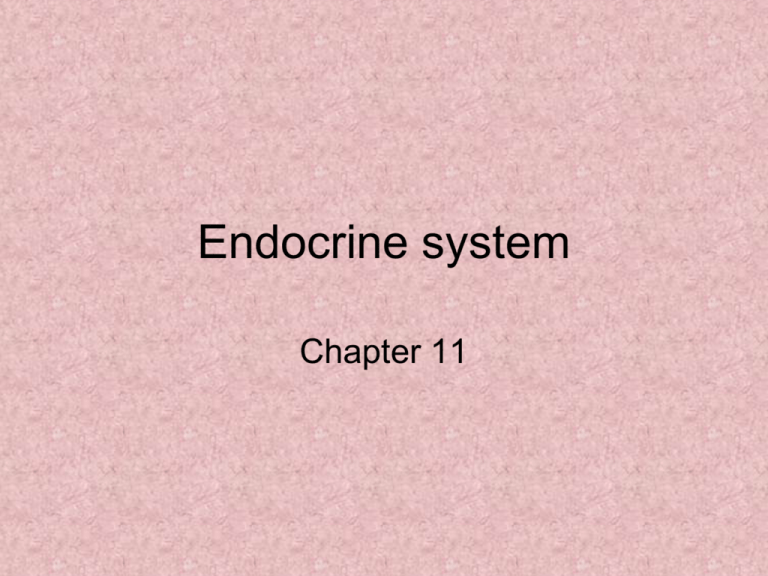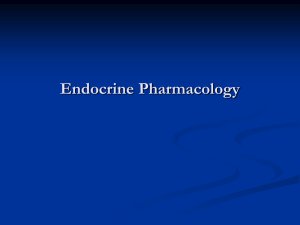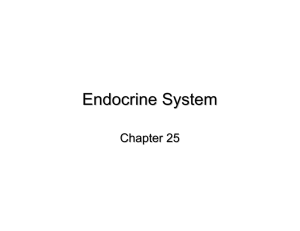Endocrine system
advertisement

Endocrine system Chapter 11 Locations Endocrine 1.The endocrine system includes cells, tissues, and organs that secrete hormones into the body. 2.The hormones diffuse into the bloodstream to be carried to the target cells of the internal organs. (cells affected by the hormones) Other glands 3.Paracrine glands – affect only cells close to the gland. 4.Autocrine glands -affect only themselves 5.Exocrine glands – produce secretions that go out through tubes or ducts to outside of the body 6.The endocrine glands work closely with the nervous system to control the homeostasis of the body. 7.The endocrine glands are very specific in the roles that they play. The endocrine system Hormones 8. Most hormones are: – Steroids – nonsteroids • • • • Amines Peptides Proteins Glycoproteins Steroids 9. Steroids are : – Insoluble in water – Composed of carbon and hydrogen atoms joined in different patterns with different chemicals attached. – Soluble in lipids (fats) – Diffuse through any cell membrane and cause the formation of new proteins Nonsteroid hormones 10. Nonsteroid hormones usually combine with receptor molecules on the cell membrane The Endocrine System 11. Hormones control several major processes –Reproduction –Growth and development –Activates body defences –Maintenance of homeostasis –Regulation of metabolism Effects Caused by Hormones 12. Effects Caused by Hormones • Changes in plasma membrane permeability • Synthesis of proteins (enzymes) • Activates or inactivates enzymes • Stimulates mitosis • Promotes of secretions Control of Hormone Release 13. Control of Hormone Release • Hormone levels in the blood are mostly maintained by negative feedback • A stimulus or low hormone levels in the blood triggers the release of more hormone • Hormone release stops once an appropriate level in the blood is reached 14. LOCATION OF GLANDS • PITUITARY – BASE OF BRAIN • THYROID – NECK • PARATHYROIDS – NECK, BESIDE THYROID • ADRENAL – ON TOP OF THE KIDNEYS • PANCREAS – JUST BELOW THE STOMACH 15. LOCATION OF GLANDS • THYMUS – (**FOUND IN CHILDREN, DEGENERATES DURING ADULTHOOD**) - ANTERIOR MEDIASTINUM • PINEAL – IN THE BRAIN • TESTIS – LOWER EXTERNAL MALE • OVARIES – PELVIC CAVITY FEMALE • OTHERS – OTHER ORGANS CAN PRODUCE HORMONES 16. HORMONES PRODUCED • PITUITARY: – GROWTH HORMONE <GH> (CAUSES CELL GROWTH) – ANTIDIURETIC HORMONE <ADH> (DECREASES URINE FORMATION) • THYROID: – THYROXINE (REGULATES METABOLISM) – CALCITONIN (REGULATES BLOOD CALCIUM LEVELS 17. HORMONES PRODUCED • ADRENAL GLANDS – EPINEPHRINE <ADRENALIN > AND NOREPINEPHRINE (INCREASE HEARTRATE, BLOOD PRESSURE, BREATHING, AND BLOOD GLUCOSE FOR THE FIGHT OR FLIGHT RESPONSE) – CORTISOL (AFFECTS GLUCOSE METABOLISM) 18. HORMONES PRODUCED • PANCREAS – GLUCAGON (STIMULATES THE LIVER TO BREAKDOWN SOME NONCARBOHYDRATES) – INSULIN (PROMOTES GLUCOSE USE) • PINEAL – MELATONIN (HELPS REGULATE THE BIOLOGICAL CLOCK) 19. HORMONES PRODUCED • THYMUS – THYMOSINS (PLAYS ROLE IN DEVELOPMENT OF WHITE BLOOD CELLS AND IMMUNITY) REPRODUCTIVE GLANDS • OVARIES – ESTROGENS AND PROGESTERONE (FEMALE CHARACTERISTICS AND REPRODUCTION) • PLACENTA – ESTROGENS, PROGESTERONE, AND GONADOTROPIN (REPRODUCTION) • TESTES – TESTOSTERONE (MALE CHARACTERISTICS) 20. HORMONES PRODUCED • OTHER ORGANS PRODUCE HORMONES NEEDED BY THE BODY. • ORGANS THAT PRODUCE HORMONES INCLUDE: – STOMACH – HEART – KIDNEYS 21. STRESS • FACTORS THAT STIMULATE A RESPONSE BY THE BODY ARE CALLED STRESSORS. • THE BODY NEEDS STRESS TO TRIGGER CHANGES NEEDED FORMAINTAINING HOMEOSTASIS. 22. TYPES OF STRESSORS • PHYSICAL FACTORS – EXPOSURE TO HOT OR COLD – INJURIES OR INFECTIONS – PROLONGED HEAVY EXERCISE – LACK OF OXYGEN – LOUD SOUNDS 23. TYPES OF STRESSORS • PSYCHOLOGICAL FACTORS – ANGER – GRIEF – FEAR – ANXIETY – LOVE – JOY – HAPPINESS 24. PHYSIOLOGICAL RESPONSES • • • • INCREASE BLOOD GLUCOSE LEVEL INCREASED HEART RATE INCREASE OF BLOOD PRESSURE INCREASED PRODUCTION OF STOMACH ACIDS • HEADACHES • MUSCLE TENSION • DISRUPTION OF NORMAL BODY ACTIVITIES








